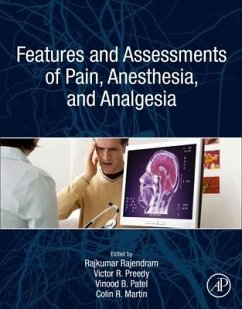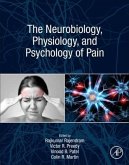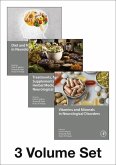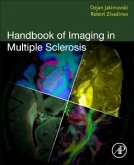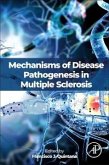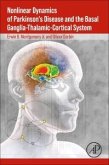Features and Assessments of Pain, Anesthesia, and Analgesia
Herausgeber: Rajendram, Rajkumar; R Martin, Colin; Patel, Vinood B; Preedy, Victor R
Features and Assessments of Pain, Anesthesia, and Analgesia
Herausgeber: Rajendram, Rajkumar; R Martin, Colin; Patel, Vinood B; Preedy, Victor R
- Broschiertes Buch
- Merkliste
- Auf die Merkliste
- Bewerten Bewerten
- Teilen
- Produkt teilen
- Produkterinnerung
- Produkterinnerung
Features and Assessments of Pain, Anaesthesia and Analgesia examines the syndromes of pain and how they interlink with anesthesia and analgesics. The book covers assessments, screening and resources, and provides applications to related areas of medicine. It explores how the perception of pain results from a multifaceted interaction between illness beliefs, age, gender, time of onset, stress, socioeconomic status, and any number of other factors. In addition, the book scrutinizes how the neuroscience of pain in one condition may be relevant to understanding pain observed in other conditions.
Andere Kunden interessierten sich auch für
![The Neurobiology, Physiology, and Psychology of Pain The Neurobiology, Physiology, and Psychology of Pain]() The Neurobiology, Physiology, and Psychology of Pain262,99 €
The Neurobiology, Physiology, and Psychology of Pain262,99 €![Treatments, Mechanisms, and Adverse Reactions of Anesthetics and Analgesics Treatments, Mechanisms, and Adverse Reactions of Anesthetics and Analgesics]() Treatments, Mechanisms, and Adverse Reactions of Anesthetics and Analgesics262,99 €
Treatments, Mechanisms, and Adverse Reactions of Anesthetics and Analgesics262,99 €![Nutrition and Neurological Disorders Nutrition and Neurological Disorders]() Nutrition and Neurological Disorders570,99 €
Nutrition and Neurological Disorders570,99 €![Handbook of Imaging in Multiple Sclerosis Handbook of Imaging in Multiple Sclerosis]() Handbook of Imaging in Multiple Sclerosis158,99 €
Handbook of Imaging in Multiple Sclerosis158,99 €![Mechanisms of Disease Pathogenesis in Multiple Sclerosis Mechanisms of Disease Pathogenesis in Multiple Sclerosis]() Mechanisms of Disease Pathogenesis in Multiple Sclerosis157,99 €
Mechanisms of Disease Pathogenesis in Multiple Sclerosis157,99 €![Alzheimer's Disease Research Guide Alzheimer's Disease Research Guide]() Takaomi C SaidoAlzheimer's Disease Research Guide151,99 €
Takaomi C SaidoAlzheimer's Disease Research Guide151,99 €![Nonlinear Dynamics of Parkinson's Disease and the Basal Ganglia-Thalamic-Cortical System Nonlinear Dynamics of Parkinson's Disease and the Basal Ganglia-Thalamic-Cortical System]() Erwin B Montgomery JrNonlinear Dynamics of Parkinson's Disease and the Basal Ganglia-Thalamic-Cortical System210,99 €
Erwin B Montgomery JrNonlinear Dynamics of Parkinson's Disease and the Basal Ganglia-Thalamic-Cortical System210,99 €-
-
-
Features and Assessments of Pain, Anaesthesia and Analgesia examines the syndromes of pain and how they interlink with anesthesia and analgesics. The book covers assessments, screening and resources, and provides applications to related areas of medicine. It explores how the perception of pain results from a multifaceted interaction between illness beliefs, age, gender, time of onset, stress, socioeconomic status, and any number of other factors. In addition, the book scrutinizes how the neuroscience of pain in one condition may be relevant to understanding pain observed in other conditions.
Hinweis: Dieser Artikel kann nur an eine deutsche Lieferadresse ausgeliefert werden.
Hinweis: Dieser Artikel kann nur an eine deutsche Lieferadresse ausgeliefert werden.
Produktdetails
- Produktdetails
- Verlag: Elsevier Science
- Seitenzahl: 598
- Erscheinungstermin: 14. Dezember 2021
- Englisch
- Gewicht: 1600g
- ISBN-13: 9780128189887
- ISBN-10: 0128189886
- Artikelnr.: 62114017
- Herstellerkennzeichnung
- Libri GmbH
- Europaallee 1
- 36244 Bad Hersfeld
- gpsr@libri.de
- Verlag: Elsevier Science
- Seitenzahl: 598
- Erscheinungstermin: 14. Dezember 2021
- Englisch
- Gewicht: 1600g
- ISBN-13: 9780128189887
- ISBN-10: 0128189886
- Artikelnr.: 62114017
- Herstellerkennzeichnung
- Libri GmbH
- Europaallee 1
- 36244 Bad Hersfeld
- gpsr@libri.de
I. Setting the scene: General aspects of anesthesia, analgesics and pain
1. The concept of multimorphic cancer pain: a new approach from diagnosis
to treatment 2. Recent advances in the linkage of attachment and pain: a
new review 3. The management of pain in older peopleFelicity 4. Anesthesia
and body mass: epidural depth and beyond 5. Anesthetics and analgesic
activities of herbal medicine: Review of the possible mechanism of action
6. Analgesia-first sedation and multimodal analgesia in the intensive care
unit 7. The multidisciplinary Acute Pain Service: features and experiences
8. Monitoring anaesthesia: EEG and beyhond
II. The syndromes of pain 9. Cluster headache and pain: features and
treatments 10. Migraine and pain: features and treatments 11. Complex
regional pain syndrome 12. Phantom limb pain. 13. Painful diabetic
neuropathy: The roles of microglia 14. Maternal deprivation and
nociceptiionIraci 15. Giving birth and pain 16. Abdominal Pain in
Gastroparesi 17. Appendicitis and related abdominal pain 18. Ovarian
hormones, site-specific nociception and hypertension 19. Linking the heart
and pain: physiological and psychophysiological mechanisms 20. Chronic pain
in military veterans 21. Nociception during surgery 22. Breast cancer and
nociception 23. Postoperative pain after rhinoplasty and rhinologic surgery
24. Pain response, neonates and venipuncture 25. Carpal tunnel syndrome and
pain 26. Pain and HIV 27. Pain mechanisms in computer and smartphone users
III. Interlinking anesthesia, analgesics and pain 28. Patients' and health
professionals' positions regarding the use of analgesics in cancer cases
29. Linking compression of myofascial trigger points and musculoskeletal
pain 30. Multimodal analgesia and post-surgical pain 31. Pain,
ultrasound-guided Pecs II block and general anesthesia 32. Pain control
during prostate biopsy and evolution of local anesthesia techniqes 33. Pain
reduction, in cosmetic injections: fillers and beyond 34. Anesthesia and
combat-related extremity injury 35. Spinal anesthesia: applications to
cesarean section and pain 36. Postoperative Pain Management: Truncal blocks
in thoracic surgery 37. Postoperative Pain Management: Truncal blocks in
general surgery 38. Linking analgesia, epidural oxycodone, pain and
laparoscopy 39. Levobupivacaine features and linking in infiltrating
analgesia
IV. Assessments, screening and resources 40. The Pain Catastrophizing
Scale: Features and Applications 41. The Pain Behaviour Scale (PaBS) 42.
The analgesia nociception index: features and application 43. Back Pain
Evaluation Questionnaire 44. The Back Pain Functional Scale: features and
applications 45. Cognitive impairment, pain and analgesia 46. Biomarkers in
endometriosis-associated pain 47. Biomarkers in bladder pain syndrome: a
new narrative 48. Biomarkers of statin-induced musculoskeletal pain:
Vitamin D and beyond 49. Performance-based and self-reported physical
fitness as a powerful marker of musculoskeletal pain
1. The concept of multimorphic cancer pain: a new approach from diagnosis
to treatment 2. Recent advances in the linkage of attachment and pain: a
new review 3. The management of pain in older peopleFelicity 4. Anesthesia
and body mass: epidural depth and beyond 5. Anesthetics and analgesic
activities of herbal medicine: Review of the possible mechanism of action
6. Analgesia-first sedation and multimodal analgesia in the intensive care
unit 7. The multidisciplinary Acute Pain Service: features and experiences
8. Monitoring anaesthesia: EEG and beyhond
II. The syndromes of pain 9. Cluster headache and pain: features and
treatments 10. Migraine and pain: features and treatments 11. Complex
regional pain syndrome 12. Phantom limb pain. 13. Painful diabetic
neuropathy: The roles of microglia 14. Maternal deprivation and
nociceptiionIraci 15. Giving birth and pain 16. Abdominal Pain in
Gastroparesi 17. Appendicitis and related abdominal pain 18. Ovarian
hormones, site-specific nociception and hypertension 19. Linking the heart
and pain: physiological and psychophysiological mechanisms 20. Chronic pain
in military veterans 21. Nociception during surgery 22. Breast cancer and
nociception 23. Postoperative pain after rhinoplasty and rhinologic surgery
24. Pain response, neonates and venipuncture 25. Carpal tunnel syndrome and
pain 26. Pain and HIV 27. Pain mechanisms in computer and smartphone users
III. Interlinking anesthesia, analgesics and pain 28. Patients' and health
professionals' positions regarding the use of analgesics in cancer cases
29. Linking compression of myofascial trigger points and musculoskeletal
pain 30. Multimodal analgesia and post-surgical pain 31. Pain,
ultrasound-guided Pecs II block and general anesthesia 32. Pain control
during prostate biopsy and evolution of local anesthesia techniqes 33. Pain
reduction, in cosmetic injections: fillers and beyond 34. Anesthesia and
combat-related extremity injury 35. Spinal anesthesia: applications to
cesarean section and pain 36. Postoperative Pain Management: Truncal blocks
in thoracic surgery 37. Postoperative Pain Management: Truncal blocks in
general surgery 38. Linking analgesia, epidural oxycodone, pain and
laparoscopy 39. Levobupivacaine features and linking in infiltrating
analgesia
IV. Assessments, screening and resources 40. The Pain Catastrophizing
Scale: Features and Applications 41. The Pain Behaviour Scale (PaBS) 42.
The analgesia nociception index: features and application 43. Back Pain
Evaluation Questionnaire 44. The Back Pain Functional Scale: features and
applications 45. Cognitive impairment, pain and analgesia 46. Biomarkers in
endometriosis-associated pain 47. Biomarkers in bladder pain syndrome: a
new narrative 48. Biomarkers of statin-induced musculoskeletal pain:
Vitamin D and beyond 49. Performance-based and self-reported physical
fitness as a powerful marker of musculoskeletal pain
I. Setting the scene: General aspects of anesthesia, analgesics and pain
1. The concept of multimorphic cancer pain: a new approach from diagnosis
to treatment 2. Recent advances in the linkage of attachment and pain: a
new review 3. The management of pain in older peopleFelicity 4. Anesthesia
and body mass: epidural depth and beyond 5. Anesthetics and analgesic
activities of herbal medicine: Review of the possible mechanism of action
6. Analgesia-first sedation and multimodal analgesia in the intensive care
unit 7. The multidisciplinary Acute Pain Service: features and experiences
8. Monitoring anaesthesia: EEG and beyhond
II. The syndromes of pain 9. Cluster headache and pain: features and
treatments 10. Migraine and pain: features and treatments 11. Complex
regional pain syndrome 12. Phantom limb pain. 13. Painful diabetic
neuropathy: The roles of microglia 14. Maternal deprivation and
nociceptiionIraci 15. Giving birth and pain 16. Abdominal Pain in
Gastroparesi 17. Appendicitis and related abdominal pain 18. Ovarian
hormones, site-specific nociception and hypertension 19. Linking the heart
and pain: physiological and psychophysiological mechanisms 20. Chronic pain
in military veterans 21. Nociception during surgery 22. Breast cancer and
nociception 23. Postoperative pain after rhinoplasty and rhinologic surgery
24. Pain response, neonates and venipuncture 25. Carpal tunnel syndrome and
pain 26. Pain and HIV 27. Pain mechanisms in computer and smartphone users
III. Interlinking anesthesia, analgesics and pain 28. Patients' and health
professionals' positions regarding the use of analgesics in cancer cases
29. Linking compression of myofascial trigger points and musculoskeletal
pain 30. Multimodal analgesia and post-surgical pain 31. Pain,
ultrasound-guided Pecs II block and general anesthesia 32. Pain control
during prostate biopsy and evolution of local anesthesia techniqes 33. Pain
reduction, in cosmetic injections: fillers and beyond 34. Anesthesia and
combat-related extremity injury 35. Spinal anesthesia: applications to
cesarean section and pain 36. Postoperative Pain Management: Truncal blocks
in thoracic surgery 37. Postoperative Pain Management: Truncal blocks in
general surgery 38. Linking analgesia, epidural oxycodone, pain and
laparoscopy 39. Levobupivacaine features and linking in infiltrating
analgesia
IV. Assessments, screening and resources 40. The Pain Catastrophizing
Scale: Features and Applications 41. The Pain Behaviour Scale (PaBS) 42.
The analgesia nociception index: features and application 43. Back Pain
Evaluation Questionnaire 44. The Back Pain Functional Scale: features and
applications 45. Cognitive impairment, pain and analgesia 46. Biomarkers in
endometriosis-associated pain 47. Biomarkers in bladder pain syndrome: a
new narrative 48. Biomarkers of statin-induced musculoskeletal pain:
Vitamin D and beyond 49. Performance-based and self-reported physical
fitness as a powerful marker of musculoskeletal pain
1. The concept of multimorphic cancer pain: a new approach from diagnosis
to treatment 2. Recent advances in the linkage of attachment and pain: a
new review 3. The management of pain in older peopleFelicity 4. Anesthesia
and body mass: epidural depth and beyond 5. Anesthetics and analgesic
activities of herbal medicine: Review of the possible mechanism of action
6. Analgesia-first sedation and multimodal analgesia in the intensive care
unit 7. The multidisciplinary Acute Pain Service: features and experiences
8. Monitoring anaesthesia: EEG and beyhond
II. The syndromes of pain 9. Cluster headache and pain: features and
treatments 10. Migraine and pain: features and treatments 11. Complex
regional pain syndrome 12. Phantom limb pain. 13. Painful diabetic
neuropathy: The roles of microglia 14. Maternal deprivation and
nociceptiionIraci 15. Giving birth and pain 16. Abdominal Pain in
Gastroparesi 17. Appendicitis and related abdominal pain 18. Ovarian
hormones, site-specific nociception and hypertension 19. Linking the heart
and pain: physiological and psychophysiological mechanisms 20. Chronic pain
in military veterans 21. Nociception during surgery 22. Breast cancer and
nociception 23. Postoperative pain after rhinoplasty and rhinologic surgery
24. Pain response, neonates and venipuncture 25. Carpal tunnel syndrome and
pain 26. Pain and HIV 27. Pain mechanisms in computer and smartphone users
III. Interlinking anesthesia, analgesics and pain 28. Patients' and health
professionals' positions regarding the use of analgesics in cancer cases
29. Linking compression of myofascial trigger points and musculoskeletal
pain 30. Multimodal analgesia and post-surgical pain 31. Pain,
ultrasound-guided Pecs II block and general anesthesia 32. Pain control
during prostate biopsy and evolution of local anesthesia techniqes 33. Pain
reduction, in cosmetic injections: fillers and beyond 34. Anesthesia and
combat-related extremity injury 35. Spinal anesthesia: applications to
cesarean section and pain 36. Postoperative Pain Management: Truncal blocks
in thoracic surgery 37. Postoperative Pain Management: Truncal blocks in
general surgery 38. Linking analgesia, epidural oxycodone, pain and
laparoscopy 39. Levobupivacaine features and linking in infiltrating
analgesia
IV. Assessments, screening and resources 40. The Pain Catastrophizing
Scale: Features and Applications 41. The Pain Behaviour Scale (PaBS) 42.
The analgesia nociception index: features and application 43. Back Pain
Evaluation Questionnaire 44. The Back Pain Functional Scale: features and
applications 45. Cognitive impairment, pain and analgesia 46. Biomarkers in
endometriosis-associated pain 47. Biomarkers in bladder pain syndrome: a
new narrative 48. Biomarkers of statin-induced musculoskeletal pain:
Vitamin D and beyond 49. Performance-based and self-reported physical
fitness as a powerful marker of musculoskeletal pain

